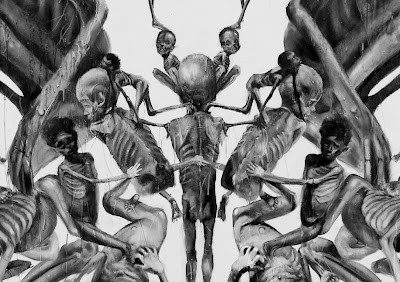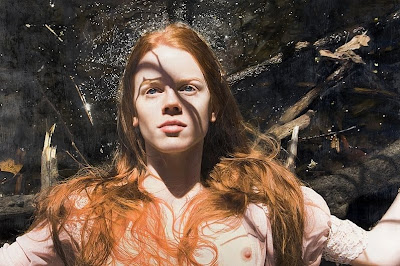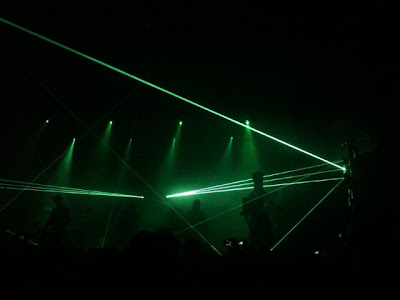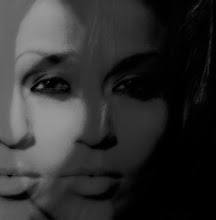September 30, 2009
Royksopp
Röyksopp 'This Must Be It' from Röyksopp on Vimeo.
"Join Runar for some odd goings-on in the new video for 'This Must Be It' courtesy of Filip and Andreas Nilsson. The single is out on November 2nd. The single features the ever-amazing vocals of Karin Dreijer Andersson (The Knife, Fever Ray) and comes complete with brand new mixes from the likes of Thin White Duke, Rex The Dog, Apparat, Danton Eeprom, Florian Meindl, LehtMoJoe, Maxime Dangles, Moguai, Pete Herbert and The Bloody Sisters (TBS)."
What Else Is There? from Röyksopp on Vimeo.
September 25, 2009
Antony Micallef: Becoming Animal
Antony Micallef's muse is the Siren...
She walks through the passages and archways of your veins with disgust and contempt for the broken muscles of your past, vexing your soul... infecting it with unwanted pleasure and sexual heat. Your core spills guts but you feel glory, while lack of redemption remains the heart of your story...
Siren (detail), oil on linen, 140x140cm
Parasite (detail), oil on linen, 280x280 cm
Face, oil on linen, 80x100cm
Red Siren (detail), oil and charcoal on linen, 140x140cm
Christ Head, oil on linen, 140x140cm
"It’s less about messages and... more about painting...and taking that as far as I can go"
"When you go to museums and see work by old masters or whatever art you are into, I think it’s important to gather knowledge because at that time you can always dismiss it. You can choose to take it on board or not. It’s a bit ignorant to think ‘I’m not looking at that type of art.’ Look at minimalism, for example. My work is not minimalist at all, but you can understand why it works. Same goes for music or anything really – it’s important to gather that knowledge before you dismiss it. Then you take a bit of it or just leave it behind."
September 24, 2009
James Turrell: Painter of Light
Turrell has been described as many things from god-like to genius, yet he identifies most with the term 'painter of light.' The skies have always been our connection to the celestial; ancient civilizations built temples of worship just to view the events of the sky. Light, shadow, time, and mathematics all prevail in the works of James Turrell, and his vision is not so much to capture them, as it is to transform the earth to accommodate such miracles in ways that the eye can experience. Most consider the experience of his works a spiritual encounter wherein one's perceptions are transformed.

The Roden Crater Project, which has been referred to as the Sistine Chapel of the United States, has been undergoing these 'celestial' transformations since 1975. The Roden Crater is said to house more than 1,000 feet of tunnels leading to seven viewing chambers. Within one of these chambers viewers experience "celestial vaulting" a phenomenon in which the sky appears to be domed rather than flat, giving the viewer the feeling that they are standing on the edge of the Earth. It also includes various skyskapes which create views from classical archways at different elevations which operate like a pinhole camera, projecting images of both the moon and sun onto a stone slab in the center of the room. Another will isolate the light of stars more than one billion years old. A space called "The Eye of the Crater" will be located 38 feet below the floor of the Roden bowl.
"It's possible to mix this light that is older than our solar system and have it bottled in a space so that you feel it physically present. You can touch it. You can have new light, eight and a half minutes old, and light that is billions of years old, and you can actually be in close contact with both of them."
"As you go up to the top of the crater, you will have to go through a tunnel, which takes you through a progression of spaces--through the fumarole space, and the sun and moon space. The reason for that is to help you to adapt to the dark. You will come from desert sunlight, which is extraordinarily bright, then you go into these darker spaces. You know the feeling of coming out of a movie theater during the day into this brutal light? This way you'll transition in a series of spaces so your dark adaptation is erased in a reasonable manner."
The Roden Crater Project will be viewable to the public in 2011, but only fourteen people a day will be allowed in: six day-trippers and eight over-night guests, who will sleep in spartan quarters furnished with Turrell-designed tables, chairs, and beds.
Gasworks (above black&white) is shaped like a gas tank. The viewer lies in a bed and enters the interior of the spherical container, and sees his or her whole body enveloped in light. Guard Blue (above blue) is a Cross-Corner Projection piece. This work uses a projector to create light in a shape that seems to have weight and mass.

"...the senses and gratification through the senses, while it can direct you toward the spiritual, is also something that will hold you from it fully. That's the limits of art, and so I don't think that art is terribly spiritual, but it's something that can be along that way, be a gesture toward that. "
Small Interview
_______________________________________________________
Partial information obtained from:
Jeffrey Hogrefe
http://www.metropolismag.com/html/content_0800/tur.htm
Jeffrey Hogrefe
http://www.metropolismag.com/html/content_0800/tur.htm
Yigal Ozeri: Brushstrokes of a Photograph
Untitled; Jessica in the park, 2009, Oil on paper, 42 x 60 inches
Untitled; Jessica in the park, 2009, Oil on paper, 42 x 60 inches
I had the luxury of seeing a full installation of Ozeri's work at the Pulse Art Fair in NYC this last March, and what I'd quickly dismissed as photograph, took me another walk-through to realize these "photographic images' were actually meticulous paintings...
September 23, 2009
Simen Johan: Re-Imaging the Unseen
Now at Yossi Milo Gallery in New York:
Until the Kindom Comes; a collection of the unseen; photographs and sculpture of secrets... proof of life beyond our own...
"solitary paths towards imagined fulfillment"
Now through October 31, 2009
Where do children go in the night, in their dreams, in their own homes? What do they do, for the short time in which they remain untarnished by the awareness of ugliness and suffering; a time where the wondrous is limitless, and nightmares are adventures to be conquered...




And what of the animals, feasting in darkness and light, roaring upwards in delight- What of their prey? Who sees battle and decay in the kingdom of the wild ones...


Under heavy fog, the difference in visibility depends on the extent of what you are willing to witness.
Until the Kindom Comes; a collection of the unseen; photographs and sculpture of secrets... proof of life beyond our own...
"solitary paths towards imagined fulfillment"
Now through October 31, 2009
Where do children go in the night, in their dreams, in their own homes? What do they do, for the short time in which they remain untarnished by the awareness of ugliness and suffering; a time where the wondrous is limitless, and nightmares are adventures to be conquered...




And what of the animals, feasting in darkness and light, roaring upwards in delight- What of their prey? Who sees battle and decay in the kingdom of the wild ones...


September 22, 2009
Gregory Euclide: Not Your Traditional Landscape

Held on history's material desire
acrylic, cigarettes, foam, milkweed, paper, pencil, plastic, styrofoam
18 x 21 x 10
acrylic, cigarettes, foam, milkweed, paper, pencil, plastic, styrofoam
18 x 21 x 10
Something similar to waves inside but lower than breaking
acrylic, paper, pencil
24 x 36
closer look With what arrived as folds and later left meaning
acrylic, bubble wrap, foam, paper, pencil, wood
24 x 30 x 9
September 21, 2009
Fever Ray: Forever Masked
Always shrouded in Mystery, singer Karin Dreijer Andersson is as compelling a preformer as her voice is haunting. Now Touring, captivated fans are drawn to experience the dark ethereal world of Fever Ray. This concert can't possibly be anything short of poetic.
Seven from Fever Ray on Vimeo.
I wear the costume he loves, forever primal. Condemned to the catacombs of truth, all my wretchedness exposed, he blinds me with acceptance, with grace. Naked forever, caressed by the brightness of being free... But the darkest corners of your stare deepen the fathoms of doubt. You’ll not survive the storm; you are not the destination.
Painlessly you are forgotten in a slew of assault and pleasure.
If I Had A Heart from Fever Ray on Vimeo.


September 20, 2009
Victoria Reynolds: Piece of Meat
Victoria Reynolds Fat Mouth, 2008
16 x 16 Inches , Oil on panel
16 x 16 Inches , Oil on panel

Victoria Reynolds Reindeer Vision (Gievvot), 2008
44 x 32 Inches , Oil on panel
44 x 32 Inches , Oil on panel
Victoria Reynolds Paints Meat. Raw Sensuous Bloody Muscular Meat. Enjoy.

Victoria Reynolds Kiss the Fat, 2005
17 x 14.25 Inches , Oil on panel
17 x 14.25 Inches , Oil on panel
32 x 43.75 Inches , Oil on panel
September 19, 2009
September 18, 2009
Picasso: The Vandal
Photo: Gjon Mili/Time & Life Pictures/Getty Images Jan 01, 1949
Light Graffiti, the latest trend in street art, can sometimes take up to an hour to create, but the result is something of a different plane, art existing in no tangible state except for what the camera's lens gathers in these prolonged states of exposure. It is no surprise then that Picasso may be the genius behind the idea.....
"In the new year of 1949, TIME photographer Gjon Mill showed the artist some of his photographs of ice skaters with tiny lights affixed to their skates jumping in the dark—and Picasso's mind began to race. The series of photographs that follow—Picasso’s light drawings—were made with a small flashlight in a dark room; the images vanished almost as soon as they were created."
Photo: Gjon Mili/Time & Life Pictures/Getty Images Jan 01, 1949
Photo: Gjon Mili/Time & Life Pictures/Getty Images Jan 01, 1949 ______________________________________
Modern Work:
Poseidon by Eric Staller
LAPP-PRO specialises in single-shot, long-exposure images manipulated with movement of light. They used a 21.1 megapixel Canon EOS 5D Mark II camera to capture these high-resolution images.
*Each of these spectacular pictures is one single photo that has not undergone any computer enhancement*
Though the best results you get through experimentation, Lichtfakor, a light crew based out of Cologne, Germany, explain the basics of every shot.
:::::::::::::::::::::::::::::::::::::::::;
These are the basics:
To get the best results you need a tripod. The exposure should be around 10-30 sec. or longer if needed. Stay in front of the camera and do your writing. Try not to overexpose but set the camera to about iso100, and close your aperture as much as possible. If there is still too much light, you might have to use a nd-filter.
We use flashlights, biking-lights and flashing LED lights as they all work with batteries. You also get nice results with fireworks & torches .
To get the best results you need a tripod. The exposure should be around 10-30 sec. or longer if needed. Stay in front of the camera and do your writing. Try not to overexpose but set the camera to about iso100, and close your aperture as much as possible. If there is still too much light, you might have to use a nd-filter.
We use flashlights, biking-lights and flashing LED lights as they all work with batteries. You also get nice results with fireworks & torches .
3 different type of lights we use:
Xenon: makes a warm golden light.
LED: makes a thin precise line.
Cold Cathode: thick line/fat cap.
Xenon: makes a warm golden light.
LED: makes a thin precise line.
Cold Cathode: thick line/fat cap.
Subscribe to:
Posts (Atom)
































